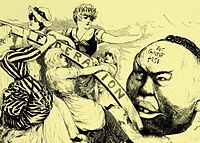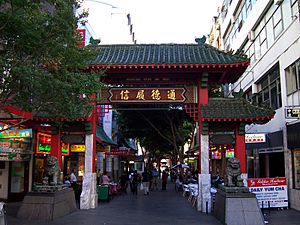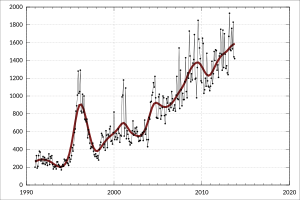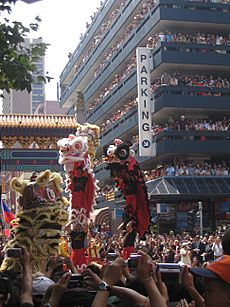History of Chinese Australians facts for kids
The history of Chinese Australians tells the story of people from China who came to live in Australia. This story might even start before James Cook arrived in the 1700s! Chinese Australians are one of the oldest groups of people to continuously move to Australia, right after those from the British Isles.
Many Chinese people started coming to Australia especially after gold was discovered and the gold rushes began. Their arrival greatly influenced Australia's rules about who could come into the country for over a hundred years. Even though they faced unfair treatment and strict immigration laws, Chinese Australians have added a lot to Australia's culture and history.
Contents
- Early Chinese Connections: Before 1848
- Workers on Contracts: 1848 to 1853
- The Gold Rush Era: 1853 to 1877
- From Miners to Artisans: 1877 to 1901
- The "White Australia Policy": 1901 to 1911
- War, Refugees, and the Republic Era: 1912 to 1949
- Cafes to Citizens: 1949 to 1973
- New Arrivals and Multiculturalism: 1973 to Today
- Images for kids
Early Chinese Connections: Before 1848
Some historians think that Indigenous Australians in the north might have met Chinese traders or found Chinese goods, especially through trading sea cucumbers. Joseph Banks, a famous botanist, even thought that Chinese people would be good settlers for a British colony in Australia.
The first clear link between China and Australia happened right at the start of the New South Wales colony. The First Fleet ships, after dropping off their convicts, sailed to Canton in China. They went there to buy tea and other goods to sell back in England. This connection meant that tea drinking became popular in the new colony very early on.
Many ships from the East India Company used Australia as a stop on their journeys to buy tea from China. It's very likely that these ships had Chinese crew members, and some of them might have stayed in Sydney. We know that by 1818, a man named Mak Sai Ying (also known as John Shying) had arrived. He farmed for a while and then, in 1829, became the owner of a pub called The Lion in Parramatta. John Macarthur, a well-known sheep farmer, hired three Chinese workers on his farms in the 1820s. Other Chinese people also came to Australia from new British areas like Malaysia and Singapore.
Workers on Contracts: 1848 to 1853
As the colony grew, there was a big need for more workers, especially after the system of sending convicts stopped in the 1840s. This led to many more Chinese men arriving in Australia. They came as workers on special contracts, often to work as shepherds or to help with irrigation for large landowners. Most of these workers came from Fujian Province through the port then known as Amoy (now Xiamen). Some might have been brought against their will, as it was sometimes called the 'sale of pigs'.
Between 1848 and 1853, over 3,000 Chinese workers arrived in Sydney to work in the countryside of New South Wales. People immediately protested against this cheap labour, and these protests were often mixed with unfair treatment. We don't know much about the daily lives of these men or their relationships with other residents, except for what appears in court records. Some stayed for the length of their contracts and then went home. However, there's proof that others lived the rest of their lives in New South Wales. For example, a man who died in Gulgong at age 105 in 1911 had been in New South Wales since 1841.
The Gold Rush Era: 1853 to 1877
The 1850s and 1860s saw the largest number of Chinese people come to Australia before the country became a federation. At its peak, around 40,000 Chinese people were in Australia. These numbers were only reached again after the unfair "White Australia policy" was removed in 1973. Gold was found in several places in Australia in 1851, but many Chinese people only started arriving to join the gold rush in late 1853.
Most of the people who came to Australia for the gold rush were from Guangdong province in China. The California Gold Rush had been called 'gold mountain' by the Chinese. The Australian gold rush was called 'new gold mountain', and it seemed like a closer and possibly richer place than America. The men were leaving their homes due to problems like too many people, a weakening government, and local conflicts.
The journey from Canton to Melbourne usually took about 3 months. Ship captains made a lot of money by fitting as many Chinese passengers as possible onto their ships. The cost of the trip was often paid through a debt system with clan leaders or the ship captains. However, some wealthier Chinese men paid their own way. These men often came to Australia to be merchants or work in other jobs besides gold mining. Most travellers were contract workers from farming backgrounds. From 1853 to 1855, thousands of Chinese people arrived in Melbourne.
It's important to know that very few Chinese women came to Australia during this time. In 1861, Australia had at least 38,000 Chinese people, and most of them were men. In fact, in Bendigo in 1861, there were 5,367 Chinese men and only one woman.
New Laws and the Walk from Robe
The large number of Chinese people arriving in Victoria worried politicians and miners. There was already a lot of tension among miners, with events like the Eureka Stockade happening in 1854. The arrival of so many Chinese people added to this tension.
In 1855, the Victorian parliament passed the Immigration Restriction Act to try and limit Chinese immigration. This law made Chinese arrivals pay a £10 tax per person. It also limited how many Chinese travellers could be on a ship based on its size. This hurt the ship captains' profits. This Act did seem to reduce the number of Chinese people arriving in Victorian ports. However, many Chinese people continued to reach the Victorian goldfields by travelling overland.
To avoid this law, many ships went to South Australia instead. Between 1855 and 1857, thousands of Chinese people landed in the Port of Adelaide and the town of Robe, South Australia. The town of Robe's population doubled overnight because of these migrants! From Robe, it was a long walk overland to the Victorian goldfields.
We don't know exactly how many Chinese people made this journey, but estimates are usually in the thousands. Groups of Chinese men often hired local guides to take them to the goldfields. As more and more Chinese people made this trip, it became more organised. Along the way, Chinese travellers created wells and paths through the bush. You can still find many signs of Chinese presence along this route today.
Life on the Goldfields
Even after reaching the goldfields, Chinese people continued to face difficulties. There was a lot of unfair feeling against Chinese miners from European miners. This led to sad events in Australian history, like the Buckland Riot in 1857 and the Lambing Flat riots in 1860-1861.
To help with these problems, the Victorian parliament set up "Chinese protectors" in 1855. These officers were meant to help organise the Chinese communities and communicate between them and local authorities. This system separated the Chinese, but the Chinese people often appreciated it. Places without these protectors, like Bucklands and Lambing Flats, were where unfair feelings turned into riots and violence. However, the Chinese did not like the extra £1 per year tax this system required.
Around most of the goldfields in Victoria, Chinese people were organised into camps. These camps were like early versions of what would later become Chinatowns. In the Bendigo area, there were seven different camps for Chinese people, and six in Ballarat. These camps were often organised by family groups or by the different Chinese languages spoken.
These camps were their own small communities. Groups of men who left China were organised, with specific jobs like barber, writer, or herbalist. Once they arrived at the goldfields, they could continue these roles. There's even evidence that the Chinese used their own money in these places. To Europeans, these camps seemed mysterious and interesting. While some people had health issues, records show that only a small number of Chinese people were treated for them.
In 1857, over 3,000 Chinese men met in Bendigo's Rosalind Park. This meeting was to protest against the many unfair laws the Victorian government had passed. They sent a petition with about 5,000 names to Melbourne.
After the gold rushes in Victoria, some Chinese people moved to other colonies to find gold there. New South Wales and Queensland had not made specific laws about Chinese people. This might have led to the Lambing Flats Riots and similar problems later on the Palmer River goldfields in the late 1870s, where Chinese miners greatly outnumbered Europeans.
Chinese Burials on the Goldfields
When Chinese people started arriving in Australia, some also started dying here. Many wanted their bodies to be sent back to China for spiritual and traditional reasons. Families went to great lengths to make this happen. Others, however, were buried in Australia. Cemeteries across the country have Chinese graves. To allow for Chinese funeral traditions that involve burning, cemeteries in Australia built special chimneys. You can still find these chimneys in cemeteries today.
The Chinese section of the White Hills cemetery in Bendigo is a very important example of Chinese graves that are still in their original state. Many other cemeteries have been changed, and the history of their Chinese sections has been lost.
From Miners to Artisans: 1877 to 1901
After the gold rushes in Victoria and New South Wales in the 1850s and 1860s, the number of Chinese people in those colonies went down a lot. However, in 1873, gold was found in far north Queensland at the Palmer River. This led to another rush, and by 1877, there were 20,000 Chinese people there. The conditions were similar to Victoria but even tougher. Chinese and European miners also faced attacks from Aboriginal tribes. After this Queensland rush ended, people either went back to China or spread out. Many Chinese people stayed in Queensland and worked hard to start much of the banana trade in the north.
In the 1880s, there was also a rise in unfair feelings against Chinese people in the cities of Melbourne and Sydney. As more Chinese people moved from country towns to the cities, these feelings grew. This led to more strict laws in New South Wales in 1881 and 1888. It also helped push for the Federation of Australia. One of the main reasons people and politicians wanted federation was to have a single immigration policy that would protect the borders of all the Australian colonies. The idea of a Chinese 'problem' was a big part of these immigration fears.
Mining remained one of the biggest jobs for Chinese people in Australia, but it became riskier as the easy gold ran out. Chinese people in country towns either started other businesses there or moved to the cities. Many of them opened stores and became merchants and travelling sellers. In 1890, in New South Wales alone, there were almost 800 shops owned and run by Chinese people.
Chinese people in Australia worked in many different jobs by the 1890s. These included clearing land, being interpreters, cooks, tobacco farmers, laundry workers, market gardeners, cabinet-makers, storekeepers, and drapers. During this time, the number of Chinese residents in Sydney and Melbourne steadily increased. Some famous Chinese Australians from this period include Mei Quong Tart, who ran a popular tea house in Sydney, and Lowe Kong Meng and Louis Ah Mouy, who were important merchants in Melbourne.
Furniture making became a major industry for Chinese people in Melbourne during this time. At its peak, there were 175 companies making and selling Chinese-made furniture. However, this success did not last. European furniture makers complained to the government, saying Chinese furniture makers were harming their businesses. The governments of Victoria and New South Wales passed laws that specifically targeted Chinese workers in that industry. Also, Victoria had a big economic downturn in the 1890s. Because of these problems, soon after 1900, there were no more Chinese people working in this industry.
The "White Australia Policy": 1901 to 1911
By the time Australia became a federation, there were about 29,000 Chinese people in the country. Chinese people in Sydney and Melbourne were a significant group, running many stores, import businesses, societies, and several Chinese language newspapers. Many Chinese people also still worked in the banana trade in northern Queensland. Tin mining in Tasmania also attracted Chinese workers.
Chinese Australians were also part of an international community. They were involved in political events in China, like sending representatives to a parliament in Peking or donating money during natural disasters. Many Chinese Australians supported the Xinhai Revolution and Sun Yat-sen.
However, the passing of the Immigration Restriction Act of 1901 caused Chinese communities from the late 1800s to slowly shrink. Thanks to Australian Chinese newspapers and many clan societies, Chinese Australians were quite a united group, even with the large distances between them. This unity can be seen in the lively discussions within the community about China's future. Some in Australia believed China should keep a monarchy, while others supported a republic and Sun Yat-sen.
Unfair treatment, both legal and social, limited the types of jobs Chinese people could do. Market gardening, which was always a big job, became the most common role for Chinese people. It was as gardeners that most Chinese people who were allowed to stay in Australia visited their home villages and started families throughout the early 1900s. They relied on a few merchants to help them deal with the strict immigration rules. Only the growth of a new generation of Australian-born Chinese people, along with new migrants sponsored by merchants (both legally and illegally), stopped the Chinese population in Australia from disappearing completely.
War, Refugees, and the Republic Era: 1912 to 1949
The fall of the Qing dynasty in China was met with mixed feelings by Chinese Australians. Some older Chinese-born men supported the reform movement. In Sydney, Chinese conservatives even had a parade to support the old government. Others, however, supported Sun Yat-sen. Some Chinese Australians even went back to China to fight for the KMT (a political party) before and after the Xinhai Revolution. The KMT had many supporters in Australia. Chinese Australians also showed their support for the republic by donating money. In 1913, Chinese Australians and others in the Chinese community around the Pacific donated £36,000 to China. A thank you letter from China's Finance Minister to Chinese Australians is on display at the Golden Dragon Museum.
World War I brought many unique challenges for Chinese Australians. By 1914, it's thought that fewer than 1,000 Chinese Australian men were old enough to fight. Of these, only about 198 men of Chinese background managed to join the AIF. One of them was the famous sniper Billy Sing. These men managed to join even though the rule was that only those with a lot of European heritage were allowed to serve.
Between the two World Wars, Australian-born people of Chinese background started to outnumber Chinese-born people for the first time. The numbers grew quickly again when refugees began to come to Australia because of Japan's war in China and the Pacific War. Some were Chinese crew members who refused to go back to Japanese-controlled areas. Others were people from Pacific islands who were moved away from the Japanese advance. Still others were Australian-born people who could leave Hong Kong and their villages as the Japanese approached. At the same time, the war against Japan helped inspire new organisations focused on China, aiming to make Australia aware of the danger from Japan and the need to help China. Some of these organisations, like the Chinese Youth League, still exist today.
Cafes to Citizens: 1949 to 1973
After World War II, the main policy was to help people fit in, which led to some new rights and gradual changes to citizenship laws. At the same time, cafes started to replace market gardens as the main source of jobs and a way to bring in new migrants, both legally and illegally. These changes, along with more Australian-born Chinese people and the arrival of Chinese students from different parts of Asia, meant that the strong link between southern China and Australia that had lasted for almost 100 years began to change.
New Arrivals and Multiculturalism: 1973 to Today
When the "White Australia Policy" finally ended, new arrivals came from Chinese communities around the world. For the first time, many people came from parts of China where they did not speak Cantonese. The first group of arrivals were Chinese refugees from Vietnam and Cambodia in the 1970s. This was followed by people moving for economic reasons from Hong Kong in the 1980s and 1990s. Often, their families settled in Sydney while the main earner went back to Hong Kong to keep working.
After the Tiananmen Square protests of 1989, the Australian Prime Minister, Bob Hawke, allowed students from mainland China to live in Australia permanently. Since then, more and more immigrants from mainland China and Taiwan have arrived. New groups were created for these new arrivals, and older ones, like the Chinese Chamber of Commerce, were brought back. Chinese language newspapers were published again. Because citizenship laws became fair and families could reunite after 1972, the old problem of having many more men than women in Chinese communities in Australia was no longer an issue for these later migrations.
Chinese newspapers are published in Australia, and there are radio channels that broadcast in Mandarin and Cantonese. The Australian public broadcaster SBS also has Chinese television and radio programs on weekends. Chinese Australian social websites also became popular. Several Chinese Australians have received the Order of Australia award, and there are Chinese Australians serving in both State and Federal parliaments.
Chinese immigration has steadily increased since the 1990s, and today, Chinese people are the third largest group among immigrants. Since the mid-1990s, moving to Australia has become less permanent than it used to be, and people now move in more than one direction. Students and academics are examples of this trend. In 1990, Chinese settlers rarely returned permanently, but by 2002, the number of Hong Kong settlers leaving Australia for good was the same as those arriving that year.
In 2005-2006, China (not including Hong Kong or Macau) was the third main source of permanent migrants to Australia, after the United Kingdom and New Zealand. Between 2000-2001 and 2005-2006, the number of skilled migrants coming to Australia from China more than tripled, from 3,800 to 12,500 people.
Images for kids










